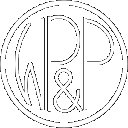I am working on creating a "historical" game map for the Paston Valley
Lines, which grew up into the WP&P. You begin the game as a
majority-owned subsidiary of the Baltimore & Ohio, but as times get
tough for B&O they look to sell off their stake in your company.
You have the choice of whether to allow this or not, but if you
do then you'll start to look interesting to the Norfolk & Western,
who begins investing in shares in your company. If N&W gets a
controlling interest, they may want to merge with you! Of course,
this is the fiction behind my WP&P, and this game map places it all
in a very plausible context. It is a big map, one which I am
using to test my route surveying skills, because the WP&P mainline
between Trellisville and Oxmore crosses some rather difficult terrain.
I will post a link to this map once I am confident it is ready for use. Check back later, or bug me about it with some
email!
Jump To:
My Maps / Scenarios
WPPscenario.zip
- This is the first time I have uploaded this scenario, though I have
spent a lot of time playtesting it myself and gone through several
iterations. If you have browsed the rest of my web page, you might
already know a bit about the W.P.& P., but this map is one that
really tells the story of the line. It's all fictional, of course,
crafted by me, except for the B&O and N&W railroads, which are
rather faithfully represented. It starts in the 1890's, at a time when
the B&O is having some financial troubles, and you begin as if you
are a wholly-owned subsidiary of B&O. To make it through the tough
times, though, B&O wishes to sell off its controlling interest in
your little Paston Valley Lines, and it's up to you to take them up on
this offer, and build your own line to cross the Appalachians!
Depending on the choices you make, you might even end up becoming a
subsidiary of N&W, much as the "real" WP&P did in 1967.
This map requires additional mod content, so please read the ReadMe and
be sure to install it all! Basically, you need engines, from the
Unofficial Loco Pack
available at hawkdawg.com, as well as the two N&W engines that Kimmo Jaske (Bombardiere) and I created,
available here. I have provided some railroad heralds in the zip file, including my own WP&P circle herald.
Skins and Mods for RRT3
New Buildings
YARD FACILITIES
The basic concept behind the "Yard" class of buildings is
that they have a fractional demand (about 0.1 to 0.4 per year) for
certain types of cargo, and a player can build them in order to attract
loads in a certain direction. When the mine and the mill are vastly
separated, it can be hard to get the raw material flowing towards its
destination, and often the only way to do it by default is to route a
train all the way from A to Z. This is an ineffcient way to run a
railroad, and with the limit of double-track in the game, your lines
can get clogged with traffic pretty readily. Plus, portions of your
route might be steeper or more shallow and straight, making it hard to
determine which type of engine to assign to that long-haul train.
A Yard works by elevating the local cargo value enough so that loads
can be profitably "drop-shipped" to a relay point, then picked up on
another train and profitably delivered to the consuming industry. With
such low demand values, they are extremely sensitive to oversupply, so
you can't just make all your deliveries to a Yard in lieu of carrying
them to a final destination. You have to haul away as much as you drop
off, to try and keep the local supply near zero. This also makes it
possible to run a series of yards, to break the delivery route into
multiple segments. However, each Yard does cost a little bit in
maintenance, and from what I have seen it is a little less profitable
overall to run trains in relay versus the full distance (i.e. series
versus parallel).
The Unofficial Patch 1.06 introduces drop-shipping at a loss, which is
another way to ensure that cargo moves where it should. But what such
drop-shipping cannot do is affect the natural flow of cargo; it is
frustrating to have a station near a bunch of coal mines, but never be
able to capture that coal because the cargo value map pulls it away. By
building a Hopper Yard, the coal will have a place to collect - as long
as you haul it away from there faithfully!
I haven't been able to make these function as lineside structures the
way I would prefer; the game only recognizes Stations and Service
Towers/Sheds as valid Along-The-Rails types (it wouldn't let me create
a new type). Thus, these are in the same building category as
Restaurants (and show up as additional restaurants at the nearby
station). Just pretend that there is an invisible spur out to them, and
build them somewhere close to the station.
Here are the Yard buildings I am working on:
(click on the name to download)
| Stock Yard |
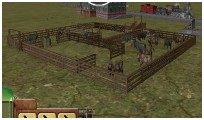 |
$65k |
Livestock |
Readme |
| Hopper Yard |
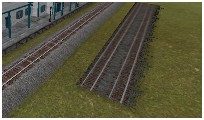 |
$200k |
Bauxite, Coal, Iron |
Readme |
| Icing Platform |
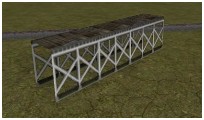 |
$240k |
Cheese, Meat, Produce, Alcohol, Milk |
Readme |
| Grain Elevator |
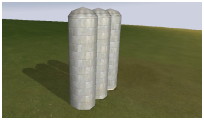 |
$240k |
Grain, Corn, Rice, Sugar |
Readme |
| Marshalling Yard |
(COMING SOON) |
$200k |
Logs, Pulpwood, Lumber, Oil, Diesel |
|
| Classification Yard |
(COMING SOON) |
$450k |
Most other "unfinished" loads (Paper, Aluminum, Cotton, etc.) |
|
I will not be creating Yards for come cargoes, since the "finished"
loads (like Furniture and Toys) are demanded by houses, and it is
assumed that you'll never lack a place to carry them. Of course, by
that reasoning there's no real need for the Icing Platform, but I had
ot try and do one anyways, as such platforms were such a staple of
classic railroading.
OTHER STUFF:
As an architect by trade, I love the thought of adding
new buildings to the game. Being limited to the existing set of
building shapes is tough, but with decent reskinning and use of the
alpha channel, I think a lot more variety can be had. My first
step was to think up all sorts of push-the-limits kinds of things, but
finding a lot of frustration with that, I decided to see what was
really possible just using the kinds of cargo in the default game.
I crafted a quick Excel spreadsheet to map out the game-provided
industries, in terms of what they demand and produce, and then started
trying to think up industries that would fill in some of the blanks.
If you would like to look at or make use of my Excel file, feel
free to download it here:
BuildingPlannerMRR
(ZIP file, creates Excel file) UPDATED 11/01/07: Now includes a
"BCA Roadmap" worksheet to aid in structuring the BCA files within a
hex editor; this is based on PJay's text file which contains the same
information, but makes it more graphical and uses in-cell drop menus
for most entries. Does not ouput to the BCA file format!
Just helps you see what you're doing (or doing wrong, as the case
may be). Feedback on this tool is desired and appreciated.
I am trying to prioritize the buildings that make the most sense; some
of what I had come up with might not really add much playability to the
game. Here are some of the basic concepts behind some of the
listed buildings:
- Open Pit Mines: Mines that get a bonus to production when provided
with Ammunition (i.e. explosives). Would use a large Steel or
Alum. Mill with most features invisible, to reflect large footprint of
this form of mining (and its tendency to terra-form)
- Company Towns: Versions of logging camps and coal mines that produce
more if supplied with Goods. Effort is to redefine "Goods" as a
catch-all top level commodity that eventually most cargo gets
transformed into. With several new buildings being Goods
producers, overall demand for Goods must increase as well. This
would be a way of representing some really small towns, like in a West
Virginia "Holler", without using up a "City" placement in the editor.
- Player-buildable farms: Not sure if this is possible yet, but it
would be nice to be able to plant some farms at whim. Since these
would just be an alternate form of the basic farm, it could be enabled
on a scenario basis. Unsure how worthwhile this would be.
- Other "pure" industries: Just work like other industries, converting one cargo into another.
Here is the first such industry I have modded, a Cereal Company:
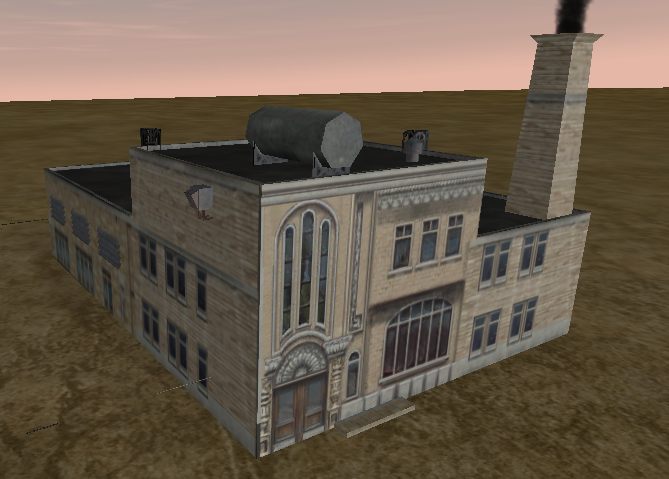
It costs 2,300k to build, starting in 1848, and it converts various
recipes into goods. Over time, the recipe changes, as its BCA
file is based on the Weapons Factory, and this is good because it helps
offset how reliably profiitable it can be. It starts by taking in
Grain plus Rice to produce 2 Goods, then switches to Corn plus Sugar,
then finally to Grain plus Sugar. I scaled this production ratio
back to control how profitable it is, and also limited total production
to 3 per year (6 when upgraded); nonetheless it seems like it can still
be rather lucrative when well-supplied. Give me your feedback and I can try tweaking the production formula a little more. The 3DP file is based on the Munitions
Factory, skinned with parts borrowed from the Commercial buildings.
I may do some more work on the skins to try and get rid of the
yellow glow at night and the black ghost edges of things I've made
invisible, and for some reason I can't get the 2D file to look good; I
would appreciate help with that. I also don't know how much is
supposed to be packed into a PK4 file; because it is still a
work-in-progress, I haven't attempted to do so.
Download the Cereal Company (CerealCompany4.zip) (if you downloaded prior to 11/02/07, replace files with these)
11/02/07 Updated files are:
CerealCompany.bca (if you prefer, just download the BCA file and replace it, in Data/BuildingTypes)
10/25/07 Updated files are:
2Dcerealcompany_a.dds (also JPEG and TGA versions of this file, in case DDS does not work)
cerealcompany_a.tga
cerealcompany_b.tga
cerealcompany_c.tga
cerealcompany_d.tga
cerealcompany_e.tga
Install instructions: Unzip and place most of the contents into
"UserExtraContents". However, the files that begin with "2D..."
go into the Data/2D folder, and the BCA and BTY files go into the
Data/BuildingTypes folder. I'll write up a Readme for the final
version, I promise...
Why this building first? Because covered hopper traffic is now
and has for a long time been very prominent in American railroading, at
least, and this creates more reason to haul the various types of "chop"
loads, even prioritizing them. Because they are recipes (a+b=c)
it means that you must probably serve two distinct growing regions in
order to get anything out of it; when you do so, it becomes wonderfully
profitable, much as a steel mill can be when you get both iron and coal
to it. However, sugar requirement may "break" it in some
scenarios, unless sugar is made available as an import product, or via
another new building (see Corn Syrup Bottler, below).
NEXT ON THE HORIZON:
I really like the idea of a Tannery, which converts Livestock into
Clothing. I first thought that maybe 1 cow = 2 shirts, but then
this might be too profitable; I just don't want large streams of
bovines marching off to such an industry, when really I think it is the
case that cows which get slaughtered for meat end up yielding their
hides to the tannery as well. Maybe this isn't so much of an
issue.
A Packaging company that converts Paper into Goods - would make paper
more valuable but flood the goods market more, thus the need for
"company towns".
Bring back the Cannery! Two recipes, either Produce+Alum=Goods or
Coffee+Alum=Goods. This would make aluminum more valuable.
Tractor Plant: An interesting twist, this would be like an Auto
Plant that in game terms produces Fertilizer! Since Fertilizer
supports all Farm production, the John Deere production line ends up
creating equipment that helps the farmer as much as fertilizer does.
Ethanol Plant - available in the 1990's, it would convert either Corn or Sugar into Diesel.
Plywood Mill - it creates Lumber out of Pulpwood instead of Logs.
Tree Farm - to support the Plywood Mill, this would be a type of Farm
that has little pine trees as its crop, if this can be done. It
produces Pulpwood, and this might be an instance of a player-buildable
farm.
Synthetics Factory - converts Chemicals into Rubber, offering another
way to get the automobile industry off the ground (it fails in so many
scenarios because of the lack of rubber farms and remoteness of
importing ports). Also boosts importance of Chemicals, which may
help Fertilizer production as Chem. loads start flowing around the map
more.
Corn Syrup Bottler - might be a necessary partner to the Cereal
Company, just to get some local Sugar production going. It would
convert Corn into Sugar.
Poultry Company - a chicken-grower which converts Corn into Meat, which
may mean gigantic profits, unless recipe can be 2 Corn = 1 Meat.
Can it be done as recipe of 1 Corn + 1 Corn = 1 Meat?
ROLLING STOCK OVERHAUL
I have broken out the Rolling Stock Mods Project onto its own page, just
click on this link. Also, I have prepared a set of instructions for making Car mods -
see my How-To Guide!
ENGINE MODS
| N&W Class J 4-8-4 |
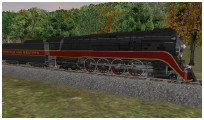 |
|
I started by doing a skin for the Northern 4-8-4 that converts it into
the N&W
Class J, perhaps the most perfect steam engine ever built.
However, since I wanted my AI company to make use of this skin
and not just use the default Northern, I asked Bombardier to help me
out by creating a stand-alone engine of it. This afforded the
opportunity to create a truly modern steam engine, one which competes
favorably with the F3, and which isn't even available until 1941 (the
game's northern begins at 1926). The image below is outdated; I
have made a few minor tweaks to the skin since then.
|
Readme |
| N&W Class Y6 2-8-8-2 |
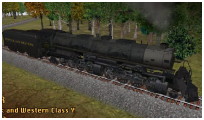 |
|
Again thanks to the efforts of Bombardier, who got the Challenger body
riding on 8-wheel driver sets and swapped out the tender, I have
completed the skinning for this new engine. It began as an
attempt to represent the Y3 class, which was based on the USRA design
in 1919 for the 2-8-8-2. N&W later improved this class into
the Y6b. For gameplay purposes, this engine represents the Y6,
because the slower Y3 just doesn't work in the RRT3 game engine; it is
too slow.
This gives a more reasonably sized mallet, a little bit earlier
(1936), for those that want big steam. This mallet is slow but
sure-footed, ugly (but oh so beautiful!) and will do best hauling ore
out of the mountains. |
Readme |
| Royal Hudson 4-6-4 |
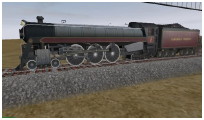 |
|
Initially, I was just going to apply a skin to the model
that Bombardier had created long before (included in the unofficial
Loco Pack and Patch 1.06), but I found that there were some things that
needed fixing. The driving rods didn't have the skin file mapped
properly onto them, which forced me to learn a bit about hex editing
the .3DP file. I also traded out the tender, for something more
proportionate to the real engine. |
Readme |
| N&W Class A 2-6-6-4 |
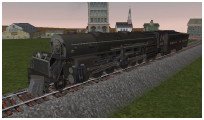 |
|
This engine represents a quantum leap forward in Mod
possibilities. I was tinkering with the Red Devil's boiler,
combined with the Challenger's lead truck, and wishing there was just
some way to lengthen the boiler a bit, move things around here and
there. If only that could be done, well then, I could make a
Class A out of it! Eventually I figured out how to manually hex
edit the .3DP file to do just that, and this is the first 3D-edited
RRT3 mod that I know about. I was told before that it simply
could not be done... |
Readme |
| Soo SD40-2 |
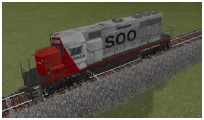 |
|
It took me three grueling weeks to get the Class A done; to
prove that 3D editing need not be so strenuous, I decided to do another
often-dreamed-about project. By starting with the GP35 body that
is part of the Coast-to-Coast expansion, and stretching its end
platforms a bit, as well as reshaping one of the radiators, I achieved
an iconic SD40-2 body. This only took me a day and a half; plus another
day to debug an issue with the truck spacing. I chose the Soo scheme
because it is mostly white and thus easy for others to paint over
(reskin). |
Readme |
| N&W SD40 M.U. |
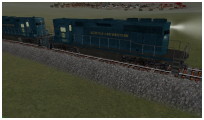 |
|
My goal all along had been to do N&W versions, but I
figured there'd be a lot of demand for a "normal" SD40-2. The
N&W liked high noses and long hoods forward, so there was a bit
more to be done, other than just a reskin. This is a doubled engine
(Multiple Unit) with stats very comparable to the DD40-X; I'm pursuing
my goal of an N&W overhaul. Personally, I think the DD40-X should
have its stats toned down a bit, as this was nowhere near as popular as
SD40-2's were, and I'm sure they cost more in maintenance than GP35's
did. |
Readme |
